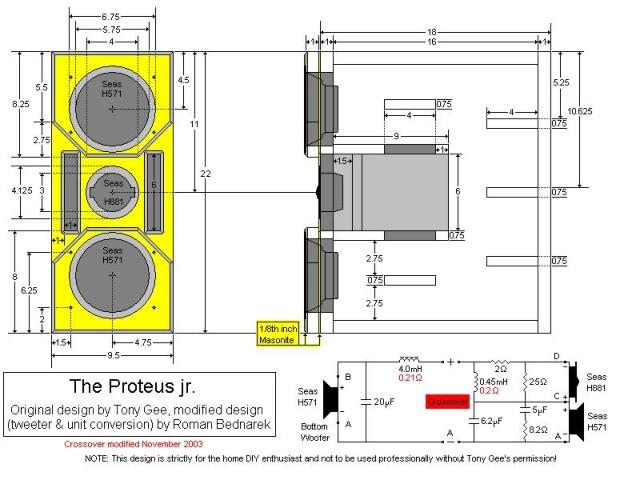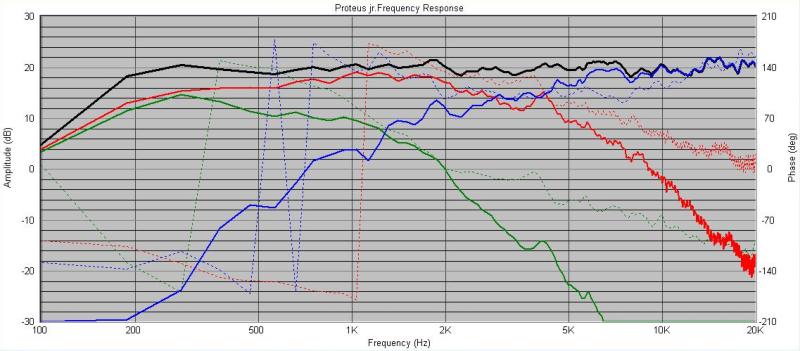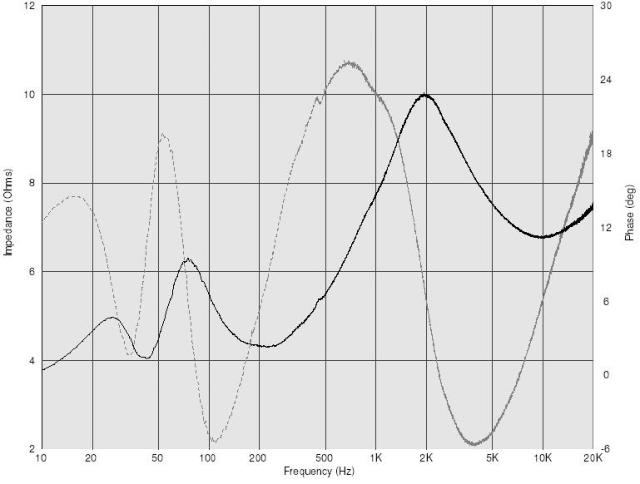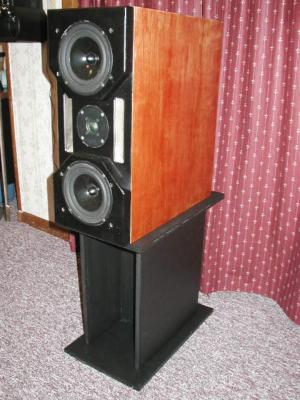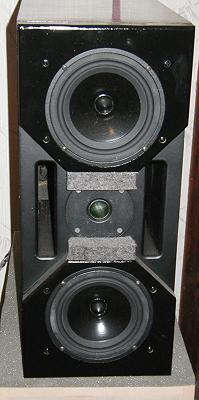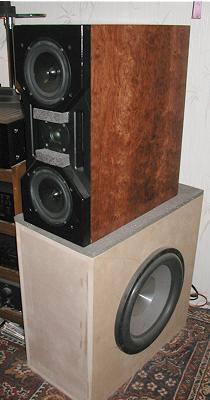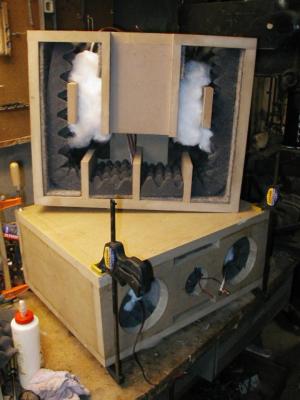
Introduction
The Proteus jr. is a modified version of designer Tony Gee's Proteus loudspeaker. The Proteus jr. is a 2.5 way design
using the Seas CB17RCY/P (H571) woofer and the Seas 27TFFC (H881) tweeter. The original Proteus design uses the Seas
Excel tweeter. The Proteus jr. was my first serious DIY loudspeaker project following several years of trying to make some
clearance Bose woofers sound good... boy I've learned a lot since then!
Drivers
Seas 27TFFC (H881)
27mm High Definition soft dome tweeter with diaphragm and integral
surround made from SONOLEX, a precoated lightweight fabric material
developed by SEAS. Combined with SEAS` unique diaphragm production
technology, this material gives superior high frequency response and
consistency compared with traditional methods and materials. Furthermore,
a very high degree of stability against changes in air temperature and
humidity is acheived. The voice coil is wound on an aluminium voice coil
former with adequate ventilating holes to eliminate noise from internal air
flow. The voice coil is immersed in low viscosity magnetic fluid, for high
power handling capacity and simplified crossover design. A stiff and stable
rear chamber with optimal acoustic damping allows 27TFFC to be used with
moderately low crossover frequencies. The chassis is precision moulded from
glass fibre reinforced plastic, and its front design offers optimum radiation
conditions.
Seas CB17RCY/P (H571)
CB17RCY/P is a 6.5" High Fidelity woofer with an injection moulded
metal chassis. The high quality paper cone and high loss rubber
surround give a smooth, accurate response which extends to 4000 Hz.
The special treatment of the cone produces a well behaved roll off
characteristic, which simplifies crossover design. The treatment of the
cone also reduces potential resonance problems. A bullet shaped
phase plug increases the power handling capacity, reduces compression
due to temperature variations in the voice coil and eliminates problems
with resonances which would occur in the volume between the dust cap
and the pole piece. A high temperature voice coil wound on an aluminium
voice coil former gives a high power handling capacity. The extra large
magnet provides extra sensitivity and low Q.
Cabinet Design
The Proteus cabinet is an MTM design with dual front ports that is basically a clone of Wilson Audio's CUB speaker design.
The ports are tuned to 45 Hz and are located to the left and right of the tweeter.
The woofers are mounted to panels that are screwed to the front of the main cabinet in order to align the acoustic
centers the woofers with the tweeter. I used tee-nuts to attach these woofer panels which provide a nice tight fit and you
don't have to worry about having the tee-nut spin and not being able to take the bolts out because you can remove the
woofers to access the nut. The inside of the cabinet is heavily braced and along with the 1" mdf that makes up the outer walls, these
cabinets are very solid. Carpeting was used to line the inside of the cabinet but I consider this step to be optional. There is also
2 1/2" thick convoluted foam to prevent internal standing waves from coloring the sound. Finally a small amount of acoustic
stuffing (Acoustastuff in my case) is placed in the cavity behind both woofers.
|
|
Crossover Design
I am a firm believer that the Proteus jr's unique sound can be attributed to the first order series crossover network they employ. The tweeter
and upper woofer are filtered with slopes of around 9dB per octave crossed over at a frequency of around 3kHz. It takes a robust tweeter to
handle such a crossover point considering the low order of the filter and the 27TFFC (H881) seems to do a fine job. It's specifications indicate
a resonance frequency of 900 Hz but I've found that most are lower than this, usually somewhere around 600 Hz. The CB17RCY/P (H571) woofer
is also a good candidate for the first order series crossover design because it has an extended top end response that allows for excellent
phase tracking between the woofer and tweeter. The 0.5 woofer provides baffle step compensation by filling in the region where the response of
the top woofer rolls off due to baffle step losses. I'm using a second order (electrical) parallel filter on the 0.5 woofer. The original Proteus used
a first order parallel filter with a zobel network. I found that the second order filter sounded better because it alleviated some of the response
peak that showed up around 1kHz.
Performance
The gated frequency resopns for the Proteus jrs is shown below. The measurement is only accurate above 300 Hz so disregard the roll off below 200 Hz.
The response is fairly flat and is easily within +/-2dB on axis with the tweeter. The phase alignment is fairly good between the drivers except the lower 0.5 woofer
drifts a bit in the range where its output diminishes. I could have gotten the phase alignment better but this resulted in a peak in the total output in the 1 kHz region.
Due to the high crossover point between the tweeter and top woofer there is a bit of vertical lobing where the phase alignment is poorer as you move off axis
vertically. Also the woofer becomes directional above the crossover point which leads to a dip in the power response above the crossover frequency. The low
crossover slopes in combination with the woofer's directionality also lead to a dip in this same region as you move off axis horizontally. For these reasons these
speakers sound best when you listen to them directly on axis and begin to sound a bit colored as you move off axis.
Basic Speaker Workshop crossover network simulations indicate that
my version of the Proteus speaker design has a flatter overall frequency response due to the upsloping response of the H881 tweeter that
my version employs which contrasts the downsloping response that the Excel tweeter has. This simulation implies that the original Proteus
design with the Excel tweeter has a stronger midrange with an attenuated upper octave. As I said above, I tweaked my version of the crossover to produce a
flatter overall response with less of a peak in the midrange region.
So they measure nice and flat, but how do they sound? Overall they sound very nice with excellent imaging and a spacious soundstage. They
don't play as deep as you might expect but this lack in bass response allows them to have a high efficiency of around 90-91dB@1m. The main issue
with them has to do with the power response issues that result from using a shallow sloped crossover with a high crossover frequency. Because there is a
dip in the power response at and above the crossover region they sound a bit strong just below this region. However, this power response dip may contribute
to their nice imaging and soundstage characteristics as well as provide a little bit of a BBC dip in the off axis response which may make them sound a bit
smoother. They
may be a tough load on some amps due to their impedance which dips down to 4 ohms in spots. I am currently using five Proteus jrs in my
surround sound setup and they sound amazing although the surrounds are a bit cumbersome and the center channel needs additional shielding
to prevent it from interfering with the TV. I've never heard the original Proteus design with the Excel tweeter but I am very happy with this design
despite the cost-cutting tweeter substitution and as I mentioned before, my version may even have a flatter overall frequency response.
Considering that they cost less than $500 to build a pair they are quite a bargain in my opinion and I can almost guarantee that you won't find
a commercial design in this price range that can compete.
Speaker Workshop Project File
The Speaker Workshop project file for this design is now available for download: Proteus jr.swd. This project file
includes gated measurements for the drivers measured on axis with the tweeter at 1 meter away
(BW stands for "Bottom Woofer" and TW stands for "Top Woofer").
There's also a crossover network simulation based on measurements taken on axis with the tweeter. The file is about 2.7 MB so be patient if
you have a slower connection.
 |


